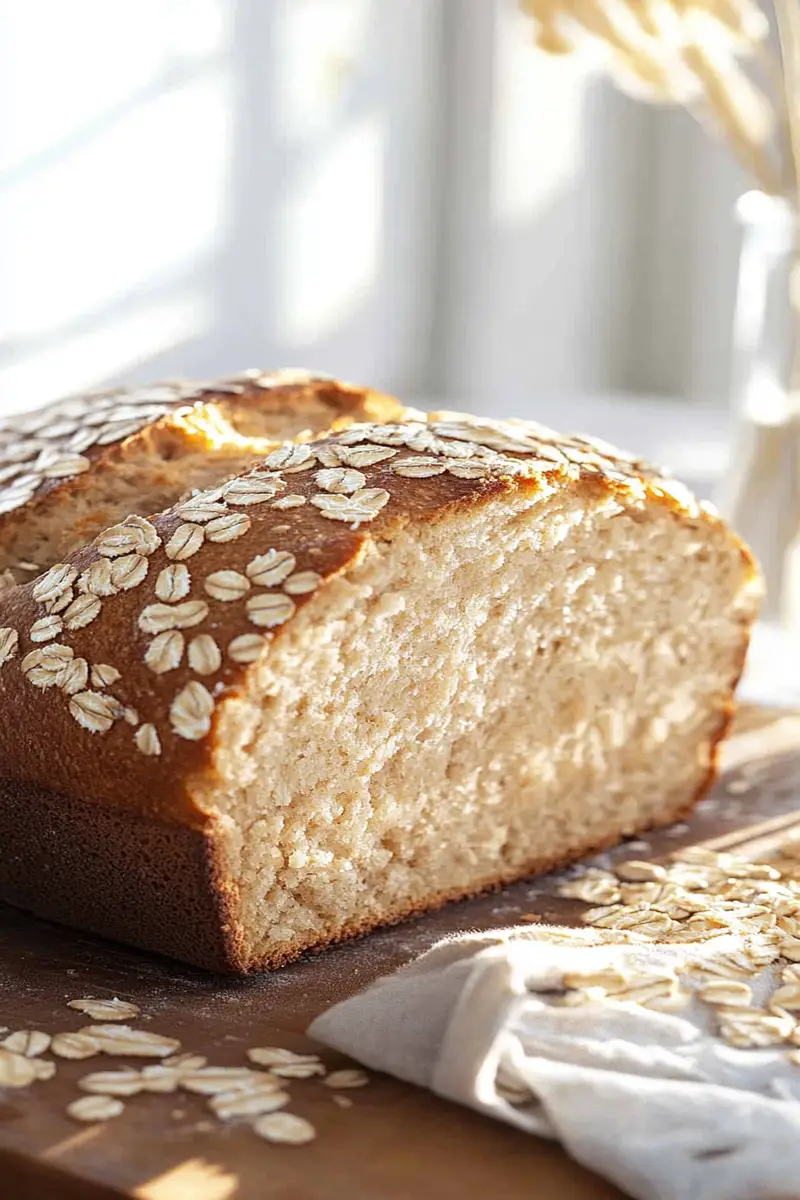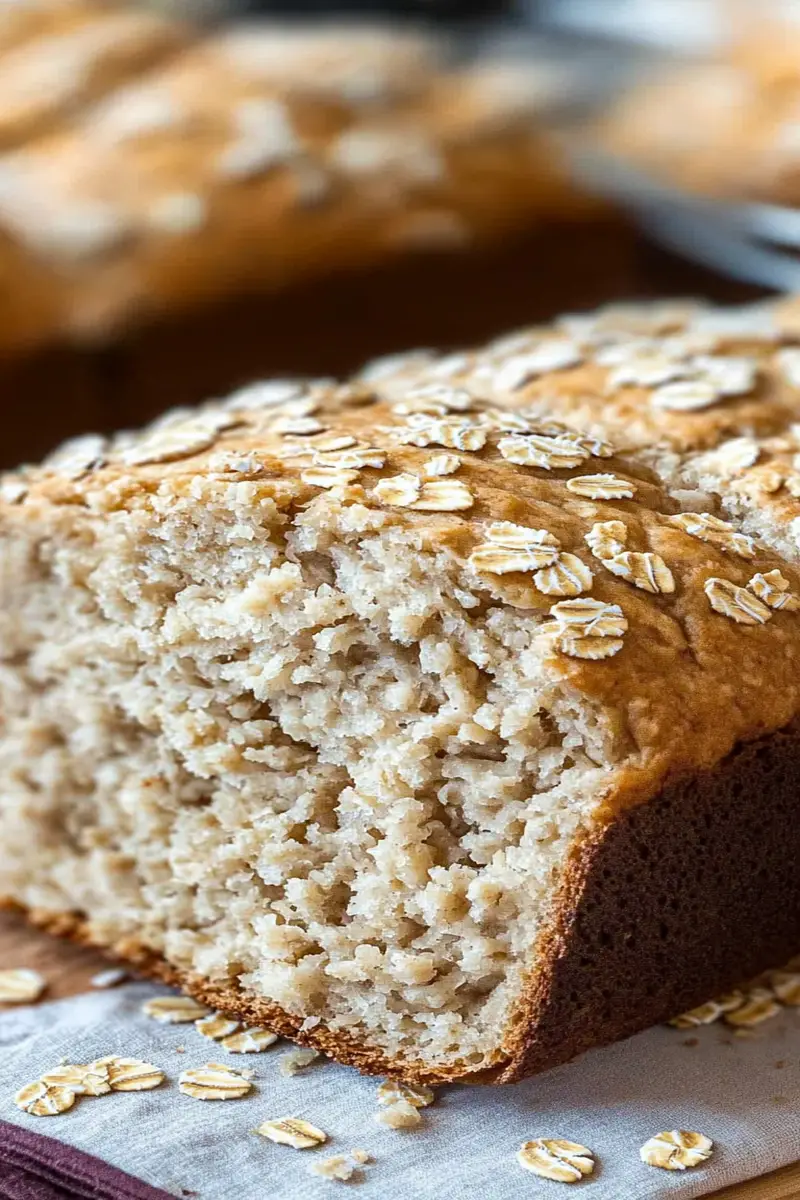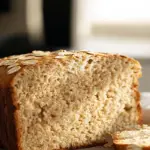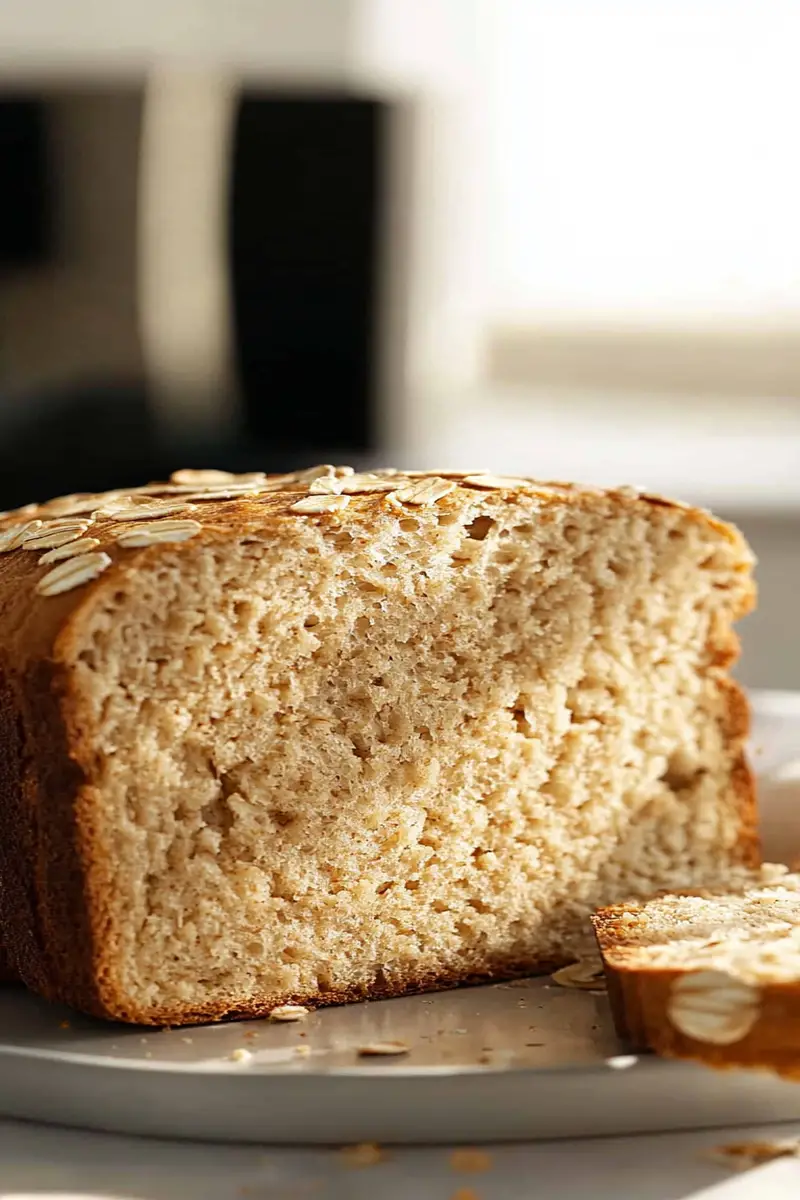Introduction and Quick Summary
If you’re looking for a wholesome and delicious option for your next baking project, oatmeal bread is an excellent choice. This delightful bread combines the nutty flavors of oats with the comforting texture of freshly baked bread. Not only is it easy to make, but it also provides numerous health benefits. Oats are rich in fiber and essential nutrients, making this bread a nutritious addition to your meals. Whether you enjoy it toasted in the morning with a bit of butter or as a base for your favorite sandwich at lunch, oatmeal bread can fit seamlessly into your diet.
In this article, we will guide you through the process of making your own oatmeal bread from scratch. We will cover all the main ingredients required to achieve the best flavor and texture. You’ll find step-by-step instructions that are easy to follow, even if you’re a beginner in baking. Plus, we’ll share some serving suggestions and storing tips to ensure your loaf stays fresh longer. So let’s get started on this exciting journey of homemade oatmeal bread!
Main Ingredients
Rolled Oats
Rolled oats are the star ingredient in our oatmeal bread recipe. They provide a hearty texture and lend a mild nutty flavor to the loaf. For this recipe, you’ll need 1 cup of rolled oats. Opt for old-fashioned rolled oats instead of instant ones to maintain the ideal texture during baking. The oats not only add flavor but also contribute important nutrients like fiber and protein, making this bread filling and healthy.
All-Purpose Flour
All-purpose flour serves as the backbone of the dough in our oatmeal bread recipe. You will need approximately 2 cups of all-purpose flour for proper structure and rise. This versatile flour allows the loaf to achieve a light yet firm texture. If you’re looking for a more nutritious option, consider substituting part of the all-purpose flour with whole wheat flour; just keep an eye on hydration since whole wheat absorbs more moisture.
Yeast
Yeast is crucial for helping our oatmeal bread rise beautifully. You’ll require 2 teaspoons of active dry yeast for this recipe. It’s best to activate the yeast before incorporating it into the dough by mixing it with warm water and sugar until frothy. This shows that it’s alive and ready to work its magic! Yeast not only aids in leavening but also contributes to the overall flavor profile of the finished loaf.
Honey
For natural sweetness, honey plays an important role in our oatmeal bread recipe. You will need about 2 tablespoons of honey to balance out the flavors while keeping the loaf moist. Honey adds just enough sweetness without overwhelming the taste buds; it complements the nuttiness of oats beautifully. Additionally, using honey helps retain moisture in your final product.
Salt
Salt is another essential ingredient that enhances all other flavors within our oatmeal bread recipe. Use 1 teaspoon of salt to ensure a well-rounded taste without overpowering sweetness or nuttiness from other ingredients. Salt also strengthens gluten structure in your dough while inhibiting unwanted yeast growth during fermentation—ensuring optimal rising conditions.

How to Prepare Oatmeal Bread
Step 1: Prepare Your Ingredients
Begin by gathering all your ingredients together on a clean workspace or kitchen counter. Measure out 1 cup of rolled oats, 2 cups of all-purpose flour, 2 teaspoons of active dry yeast, 2 tablespoons of honey, 1 teaspoon of salt, and warm water (about 1 cup). Make sure everything is at room temperature before starting; this ensures better activation rates for yeast and effective blending later on.
Step 2: Activate Yeast
In a small bowl or measuring jug, combine warm water (make sure it’s not too hot) with honey and sprinkle in the active dry yeast evenly over top without stirring initially. Allow this mixture to sit undisturbed for about 5-10 minutes until bubbles form on top—that’s when you’ll know your yeast is activated! This step is crucial because it ensures that your loaf rises perfectly.
Step 3: Mix Dry Ingredients
While waiting for your yeast mixture to activate fully, take another bowl large enough for mixing all dough ingredients together comfortably—ideally about double what you think you’ll need! In this bowl add measured rolled oats along with salt followed by all-purpose flour gradually little by little while whisking thoroughly after each addition until well combined.
Step 4: Combine Wet & Dry Mixtures
Once you’ve confirmed that your yeast has activated (it should be bubbly!), pour this mixture directly into your dry ingredients bowl along with any remaining warm water needed if necessary (the total liquid should reach around one cup). Stir using either wooden spoon or spatula until everything comes together as cohesive dough—it may feel sticky at first but should come away from sides easily once kneaded properly!
Step 5: Knead Dough
Transfer combined dough onto lightly floured surface then begin kneading gently yet firmly—this helps develop gluten which creates structure within baked goods! Knead approximately 8-10 minutes until smooth elastic consistency forms (you can perform windowpane test here). If sticky continue adding small amounts more flour as needed during kneading process—but avoid adding too much!
Step 6: First Rise
After achieving desired result from kneading stage shape formed ball then place inside greased bowl covering tightly using plastic wrap or damp cloth allowing rise time around one hour ideally at room temperature (or until doubled volume). During this period ensure no drafts disturb environment surrounding rising dough.
Step 7: Shape Loaf
Upon completing first rise punch down risen dough gently releasing excess air trapped inside—then transfer back onto lightly floured surface again shaping into desired loaf shape (either standard rectangular loaf shape or round boule depending preferences). Place shaped loaf into greased baking pan ensuring space at sides so it has room expand further during second rise phase!
Step 8: Second Rise
Cover newly shaped loaf gently using kitchen towel letting rest again around thirty minutes up till doubled size again! Preheat oven meanwhile setting temperature around four hundred degrees Fahrenheit so it’s ready once second rising completes successfully!
Step 9: Bake Bread
Once completed preheated oven carefully insert prepared loaf setting timer roughly thirty-five forty minutes depending how crusty golden brown appearance you prefer achieving final product! To determine doneness tap bottom lightly if sounds hollow it’s done otherwise return briefly checking every few minutes until ready!

Serving and Storing Tips
Serving Suggestions
Oatmeal bread can be enjoyed in numerous ways! Slice freshly baked loaves thinly serving alongside breakfast dishes like scrambled eggs or cut thicker slices perfect creating delicious sandwiches filled with meats cheeses veggies spreads etc.! Consider pairing slices toasted topped creamy avocado drizzle extra virgin olive oil sprinkling sea salt pepper making delightful open-faced sandwiches brunch spread! For added sweetness try spreading almond butter topping banana slices drizzling honey each piece bringing balance between savory sweet notes together nicely!
Storing Properly
To maintain freshness store cooled loaf wrapped tightly either plastic wrap aluminum foil placing inside resealable bag potentially refrigerated too prolong shelf life beyond typical three five days generally expected time frame without drying out too quickly overall quality-wise! Alternatively freezing sliced portions works wonders preserving flavors textures effectively; just make sure label date when stored allow thawing naturally overnight before consuming again later on enjoying same great taste freshly made had initially!
By following these steps closely anyone can create their very own homemade oatmeal bread successfully filling kitchens warmth aroma delightful pastries baking provide nourishment wholesome goodness every bite taken savoring moment shared loved ones around table enjoying togetherness created through food love cooked shared often brings people close hearts minds souls alike creating lasting memories cherished years come ahead!
Mistakes to Avoid
When making oatmeal bread, several common mistakes can hinder your results. First, using instant oats instead of rolled oats is a frequent error. Instant oats absorb water differently and may lead to a less textured loaf. Rolled oats provide the right consistency and flavor, creating a heartier bread.
Another mistake is not measuring ingredients accurately. Baking is a science, and slight variations can impact the outcome. Using a kitchen scale for precise measurements ensures that your dough rises properly and achieves the desired texture.
Failing to allow sufficient rising time is another misstep. Patience is key in bread-making; rushing this step can result in dense or gummy bread. After mixing, let the dough rise until it has doubled in size. This process allows the yeast to work effectively, leading to a lighter loaf.
Additionally, neglecting to preheat your oven can affect baking times and final texture. A properly heated oven helps create a crusty exterior while maintaining moisture inside the loaf. Always preheat your oven before placing the bread inside for optimal results.
Lastly, skipping the kneading process can lead to poor gluten development. Kneading helps strengthen gluten strands, which contribute to the structure of your oatmeal bread. Aim for a smooth and elastic dough by kneading for at least 10 minutes.
Tips and Tricks
To achieve perfect oatmeal bread, follow these helpful tips. First, consider adding extra flavor by incorporating spices or sweeteners such as cinnamon or honey into your dough. These additions enhance the taste profile without overpowering the classic oatmeal flavor.
Hydration plays an important role in baking bread. Adjusting liquid content can help you achieve the right consistency. If your dough feels too dry, add small amounts of water gradually until it becomes tacky but not overly sticky.
Using warm water or milk when mixing your ingredients can help activate the yeast more effectively. The ideal temperature for activating yeast ranges from 100°F to 110°F (37°C to 43°C). Always check that your liquids are within this range before combining them with dry ingredients.
Consider letting your oatmeal bread rest after shaping it but before baking. This technique allows gluten to relax further, resulting in a softer crumb and improved rise during baking.
Experimenting with different types of flour can yield interesting results as well. Mixing whole wheat flour with all-purpose flour enhances nutritional benefits while still providing excellent structure for your loaf.
Lastly, don’t forget about storage! Once baked, ensure you store your oatmeal bread in an airtight container at room temperature for up to three days or freeze slices for longer preservation.
Suggestions for Oatmeal Bread
To make your oatmeal bread even better, try incorporating various seeds and nuts into your recipe. Ingredients like sunflower seeds or walnuts add texture and nutritional value while complementing the oats’ natural flavor.
Another suggestion is to use buttermilk instead of regular milk or water in your recipe. Buttermilk adds richness and tanginess to the dough, contributing to a moist crumb and enhanced flavor profile.
For added sweetness without refined sugar, consider using mashed bananas or applesauce in place of some liquid ingredients. These natural sweeteners provide moisture and infuse delicious fruit flavors into each slice.
If you enjoy experimenting with textures, add cooked grains like quinoa or barley into your dough mixture. These grains not only boost nutrition but also provide delightful chewiness that pairs beautifully with oatmeal.
Using different types of oats can also lead to unique flavors and textures in your bread. Steel-cut oats offer a chewier bite compared to rolled oats while still maintaining nutritious benefits—just be sure to soak them beforehand!
Lastly, try topping your oatmeal bread with seeds before baking it for a crunchy crust that elevates its appearance and taste—even simple sesame seeds can make a big difference!
FAQs
What are the health benefits of oatmeal bread?
Oatmeal bread offers numerous health advantages due to its main ingredient: oats. Rich in fiber, especially soluble fiber known as beta-glucan, oats help lower cholesterol levels while promoting heart health. The high fiber content also aids digestion by preventing constipation and regulating blood sugar levels—making it an excellent choice for those managing diabetes.
Moreover, oatmeal provides essential vitamins like B-vitamins that support energy metabolism and immune function. Additionally, it contains minerals such as iron, magnesium, and zinc important for overall health. By choosing whole grain options when making oatmeal bread, you increase nutrient intake significantly compared to white bread alternatives.
Can I use gluten-free flour for oatmeal bread?
Yes! You can use gluten-free flour blends specifically designed for baking instead of regular flour when making oatmeal bread if needed. Many brands offer versatile blends that mimic traditional all-purpose flour’s properties while remaining free from gluten sources like wheat or barley.
However, remember that using gluten-free flour may yield different textures than conventional recipes call for—experimenting with binders like xanthan gum or psyllium husk powder will improve structure and elasticity in gluten-free versions of this delicious loaf!
How long does homemade oatmeal bread last?
Homemade oatmeal bread typically lasts about three days at room temperature if stored properly in an airtight container—this helps maintain moisture levels without allowing excess air exposure which leads to staleness over time!
For extended storage options beyond three days: slice up any leftover loaves; then wrap them tightly before freezing them individually so they remain fresh whenever you want some delicious toast later on! Properly frozen slices should retain their quality for up six months without losing flavor integrity during that time frame either!
Can I add fruits or vegetables into my oatmeal bread recipe?
Absolutely! Adding fruits like raisins or cranberries will introduce natural sweetness along with additional nutrients into each slice! Furthermore incorporating grated vegetables such as zucchini not only enhances moisture content but provides extra vitamins too!
Just keep in mind that adding these ingredients may require adjustments regarding hydration levels since they contain additional moisture themselves—feel free experiment until reaching satisfaction!
Is it possible to make vegan oatmeal bread?
Yes! Making vegan versions of oatmeal breads requires replacing eggs (if called) with flaxseed meal mixed with water or chia seeds combined with water—a common egg substitute among plant-based bakers! Additionally be mindful when selecting dairy alternatives such as almond milk instead of regular milk during preparation ensuring overall successful results while adhering strictly vegan guidelines throughout baking processes involved here too!
What should I serve with my oatmeal bread?
Oatmeal bread pairs wonderfully well alongside various spreads including nut butter options like almond butter or peanut butter which provide healthy fats plus protein enrichments perfectly complementing flavors found within loaves produced here today—it’s entirely up personal preferences though really!
Other great accompaniments include honey drizzles atop warm slices fresh out oven too; avocado spread also works nicely too if looking something savory instead! Finally considering serving alongside soups salads enhances entire meal experience making perfect pairing all around every occasion imaginable!
Conclusion
Making delicious oatmeal bread involves understanding key aspects of preparation while avoiding common pitfalls along the way! By ensuring accurate measurements are taken when combining ingredients together you’ll create loaves bursting full flavor every single time baked within homes across kitchens everywhere!
Remember though patience matters greatly during rising stages—allow ample time necessary so yeast activates properly leading lighter airy texture achieved once baked fully through afterward too! Experimentation helps keep things interesting whether trying new flours spices additions found throughout recipes shared above previously discussed here today; don’t hesitate exploring possibilities beyond just basic versions alone either continually discovering what works best suited individual tastes preferences experienced firsthand thereafter now moving forward ahead always enjoying fresh homemade goodness enjoyed daily lives ahead indeed!
Print
oatmeal bread
- Total Time: 50 minutes
- Yield: 1 loaf 1x
Description
This hearty oatmeal bread is soft, slightly sweet, and filled with the wholesome goodness of oats. It’s perfect for sandwiches, toast, or as a side to soups and stews. Easy to make, it’s a nutritious and delicious addition to your baking repertoire.
Ingredients
- 1 ½ cups rolled oats
- 1 ½ cups warm water
- 2 tbsp honey or maple syrup
- 1 ¼ tsp active dry yeast
- 1 ½ cups whole wheat flour
- 1 ½ cups all-purpose flour
- 1 tsp salt
- 2 tbsp olive oil or vegetable oil
- 1 tbsp apple cider vinegar (optional, for fluffiness)
Instructions
- In a small bowl, combine the oats and warm water. Let them sit for 10-15 minutes to soften.
- In a separate bowl, dissolve the honey (or maple syrup) in warm water and sprinkle the yeast over the top. Let it sit for 5 minutes, or until frothy.
- In a large bowl, combine the whole wheat flour, all-purpose flour, and salt.
- Add the yeast mixture and softened oats to the flour mixture, followed by the olive oil and apple cider vinegar (if using). Stir until well combined.
- Knead the dough on a floured surface for about 8-10 minutes, until smooth and elastic. If the dough is sticky, add a little more flour, a tablespoon at a time.
- Place the dough in a lightly oiled bowl and cover with a damp cloth. Let it rise for 1-1.5 hours, or until doubled in size.
- Preheat the oven to 350°F (175°C) and grease a 9×5-inch loaf pan.
- Punch down the dough and shape it into a loaf. Place it in the prepared pan and smooth the top.
- Bake for 30-35 minutes, or until the bread is golden brown and sounds hollow when tapped on the bottom.
- Let the bread cool in the pan for 5 minutes, then transfer to a wire rack to cool completely before slicing.
Notes
- For added texture, sprinkle some oats on top of the loaf before baking.
- You can replace part of the all-purpose flour with whole wheat flour for a denser loaf.
- Store the bread in an airtight container at room temperature for up to 3 days, or freeze for longer storage.
- Prep Time: 15 minutes
- Cook Time: 35 minutes


